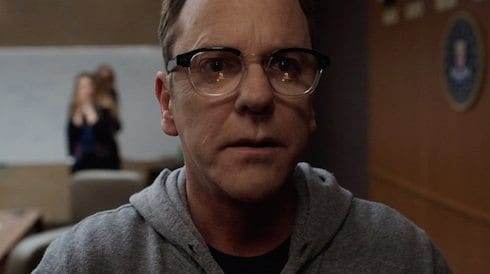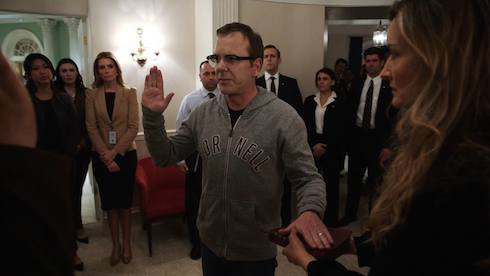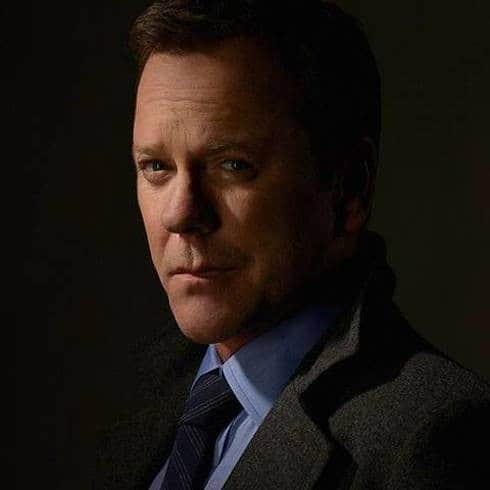Is the Designated Survivor real? How is the Designated Survivor chosen? Real-life answers to the ABC drama’s questions

Is the Designated Survivor real? How is she chosen? And where does she go? Kiefer Sutherland’s return to TV depicts a presidential nightmare: the President of the United States, almost all of his Cabinet, and almost every member of Congress are killed in a terror attack during the State of the Union address. Sutherland, in the title role, portrays the Designated Survivor: the lone Cabinet member absent from the address, intended to ensure continuity of government in the event of a disaster.
The custom, which began during the Cold War, might sound like a plot conceit concocted specifically for a TV show. But it’s very real–and very serious. The Presidential Succession Act of 1947 legalized the order of succession to the US Presidency: immediately after the President comes the Vice President, the Speaker of the House of Representatives, and the President Pro Tempore of the Senate. But, in the doomsday scenario the designated survivor is supposed to prevent, all of those people are present. (The State of the Union is the most oft-cited situation, but there are other occasions; one was President Obama’s first inauguration, in 2009). Thus, all of those people were definitely killed–vaporized, most likely–in the attack. So, after them comes the Cabinet, in the following order:
Secretary of State, Secretary of the Treasury, Secretary of Defense, Attorney General, Secretary of the Interior, Secretary of Agriculture, Secretary of Commerce, Secretary of Labor, Secretary of Health and Human Services, Secretary of Housing and Urban Development, Secretary of Transportation, Secretary of Energy, Secretary of Education, Secretary of Veterans Affairs, Secretary of Homeland Security.

So how is the Designated Survivor chosen? For one thing, the person must be Constitutionally eligible for the office. That means a) you’ve got to be at least 35 years old; b) you’ve got to have lived in the United States for at least 14 total years; c) you’ve got to be a natural-born citizen of the United States. That last item has disqualified several people over the years: Madeline Albright, Secretary of State under President Clinton, was born in Czechoslovakia; and Carlos Gutierrez and Elaine Chao, Secretaries of Commerce and Labor, respectively, under President George W. Bush, were born in Cuba and Mexico.
In addition, as former White House Deputy Chief of Staff Josh Lyman once put it, certain cabinet secretaries “are famous faces,” and each administration “wants the camera to find them.” For example, John Kerry and Hillary Clinton, the current and previous Secretary of State and the two best-known members of President Obama’s cabinet, have never missed a State of the Union address during their time in office. The same was true of Condoleezza Rice and Colin Powell, George W. Bush’s two Secretaries of State.
In truth, there is no hard-and-fast rule for how the Designated Survivor is chosen. Sometimes it’s a matter of cold, political calculation. Other times, it’s a coin toss. In 2007, President Bush’s Deputy Chief of Staff Joe Hagin chose Attorney General Alberto Gonzales simply because the choice fell to him. And, in still other times, it’s because the president himself sees something in the man, as was the case with President Bartlet and Agriculture Secretary Roger Tribbey–who looks suspiciously like the Mayor of Sunnydale CA–way back in 2000:
Where does the Designated Survivor go? The answer to that question is usually and understandably a matter of national security, and isn’t often disclosed even after the fact. We do know, based on interviews with former Designees, that the Secret Services encourages the chosen Secretary to leave Washington for the event. Former Interior Secretary Ken Salazar was the DS in 2011, and even five years later would only acknowledge that he was not in the city for his big night. Agrigulture Secretary Dan Glickman was Designated Survivor of the Year for 1997; he watched the State of the Union address with his daughter in her Manhattan apartment, surrounded by Secret Service agents, a doctor, and a military aide who allegedly carried the nuclear football in a briefcase handcuffed to his wrist. (“I didn’t get into any detail with them on that,” Glickman would later recall.)
Beyond a presidential-level security detail and motorcade, the Designated Survivor also “undergo[es] training exercises in which they’re briefed by Secret Service agents on what to do in the event of catastrophe.” But, as you might expect, the people who’ve undergone those exercises aren’t keen on disclosing what the exercises were. Based on the level of secrecy, though, and the task the DS is to perform, it seems safe to assume that the briefings entail pretty much all of the information–military, economic, and political–necessary to assume the presidency in the middle of an emergency without putting the country in further jeopardy.

But who was the designated survivor for 2016? And who’s been the designated survivor in the past? In truth, we only have detailed records of who the Designated Survivor has been each year going back to about the 1980s–the Senate Historical Office points out that, before the early 80s, the selection was generally not made public. (Which kind of makes you wonder why we publicize the choice now.)
In any case, give yourself a pat on the back if you knew that the Designated Survivor 2016 was Secretary of Homeland Security Jeh Johnson: last in the order of succession…but first in our hearts.
Click here to see the Senate Historical Office’s complete list of Designated Survivors from 1984 to 2015, and get yourself a little trivia night ammunition in the bargain. And, for a fictional version of the real deal, tune in to Designated Survivor, which premieres September 21st on ABC, and airs on Wednesday nights.
(Photo credits: Is the Designated Survivor real via ABC)



